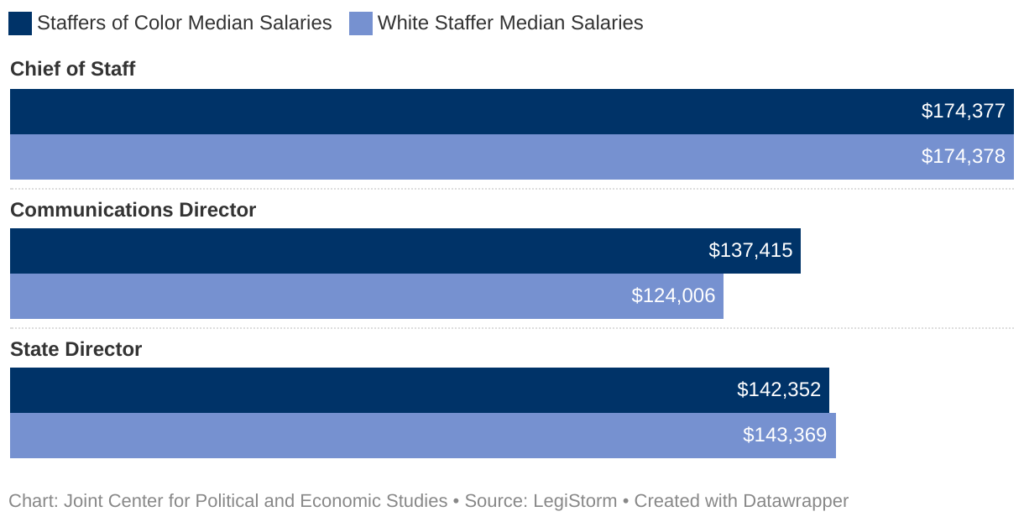Hill Diversity

Senate Staffers of Color Earn Less Pay Than Whites
Senate Staffers of Color Earn Less Pay Than Whites
Demonstrates Need to Hire More Senior-Level Staffers of Color

This week, LegiStorm, a web-based platform that identifies congressional staff, and monitors activity on Capitol Hill, shed light on one key issue in congressional staff diversity and inclusion–staff salaries. On July 11, LegiStorm published a blog that compared the projected salary of the median white Senate staffer ($63,507) to the average Black congressional staffer ($55,151). This equates to a 15.2 percent (or $8,356) difference. LegiStorm’s data also reveals that disparities also exist among other staffers of color. State staffers of color across Democratic and Republican offices make 91 percent compared to white state staffers, or $5,600 less per year. The gap is higher in D.C. offices, where the Senate pays staffers of color 86 percent that of white staff, or $9,100 less per year.
The data provided in LegiStorm’s blog may point to potential pay disparities between staffers of color and white staffers, but since this data does not compare the salaries by position, we cannot ascertain whether staffers of color earn less compensation for equal work or if this difference indicates something else.
For instance, according to LegiStorm’s data comparing Senate key roles, the median salary of chiefs of staff is $174,377 for staffers of color and $174,378 for white staffers. The median salary of communications directors is $137,415 for staffers of color and $124,006 for white staffers. The median salary for state directors is $142,352 for staffers of color and $143,369 for white staffers. The chart below demonstrates that the chiefs of staff and state directors, regardless of race/ethnicity, earn around the same salary. We should note, however, that there was a significant difference between the salaries of staffers of color and white communications directors. Additional research should be done to further study why that salary gap exists. These salary comparisons do not account for staffers’ tenure, which may be a potential reason for this discrepancy.
Chart 1:
*LegiStorm did not provide analysis for the Legislative Director position
These differences may reflect what Joint Center research has consistently demonstrated: congressional offices lack staff diversity at more senior levels, which may account for the salary discrepancies. As demonstrated in our 2020 report, Racial Diversity Among Top Staff in Senate Personal Offices, people of color make up 40 percent of the U.S. population, but only 11 percent of all Senate personal office top staff (i.e., chiefs of staff, legislative directors, and communications directors). African Americans account for 13.4 percent of the U.S. population, but only 3.1 percent of Senate personal office top staffers.
Chart 2:
Senators and their staff invest significant time and resources providing constituent services in their state offices, so it is essential to understand the demographic makeup of the state directors who manage these offices. The Joint Center analyzed the diversity of Senate staff in state offices who responded to the survey as of Jan. 31, 2022. The Joint Center’s analysis finds that people of color make up 40 percent of the U.S. population, but only 24.2 percent of Senate state directors.
Chart 3:
Recent data reveals that 40 percent of Senate Democratic staff identified as a person of color and according to LegiStorm, only eight percent of Senate Republican staffers are people of color. The gap between these aggregate Senate office statistics and Joint Center research on top staff diversity and state director diversity reveal that staff of color are disproportionately relegated to lower-level positions. Hence, the median salary differences in the aforementioned LegiStorm blog may be attributed, in part, due to job type and title.
Senators should follow the lead of the U.S. House of Representatives by establishing an Office of Diversity and Inclusion (OD&I) that develops a diversity plan that focuses on recruiting, hiring, training, promoting, and retaining a diverse Senate staff. In May, the Joint Center, Demand Progress, and the National Association of Latino Elected and Appointed Officials Educational Fund prepared and submitted testimony for the Legislative Branch Appropriations Subcommittee urging it to create an independent Senate OD&I office. Absent immediate bipartisan cooperation to create such an office, Senate Republicans should at least match the practices of Democrats by creating their own diversity initiative to help Republican offices advance racial diversity and disclose data to monitor progress.
Diversifying top staff in Congress is especially important now, as the lack of top staff diversity impairs the ability of Senators to understand the diverse perspectives of their states, and to effectively represent all Americans.

